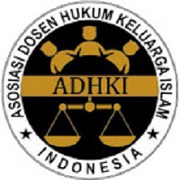-
- ARTICLE TEMPLATE
Fulfillment of The Living Rights of Children the Victims of Divorce in the Muslim Community of Lombok, Indonesia
Abstract
This research examines the effectiveness of fulfilling the livelihood rights of children, the victims of divorce, the inhibiting factors, and how alternative solutions solve the problem of providing for children in Lombok Island, West Nusa Tenggara, Indonesia. This research is field research. The research data includes primary data and secondary data. The primary data is data obtained from respondents, informants, and resource persons. Data collection techniques in this research used interview techniques, observation, and documentation. The data that had been collected was inventoried and classified and then analyzed using the deductive method to draw conclusions. The results of this study indicate that fulfilling the livelihood rights of children of divorce victims in Lombok, West Nusa Tenggara, Indonesia is not very effective. Research data shows that 45% of children who are the victims of divorce are not given a living right at all, and the remaining 55% are given a living but not by the nominal needs of the children, 24% of children are given a living of 100,000-300,000 thousand per month and 31% of children who are the victims of divorce are given a living of 350,000 -500,000 thousand rupiahs. Factors inhibiting the fulfillment of children's livelihood and education rights are 42% due to negligence, 26% due to marriage, 21% family conflict, and 11% due to economic factors. An alternative solution to overcoming the problem of fulfilling children's livelihood rights is socialization law, tabayyun and deliberation, religious approach, and legal approach.
Keywords
Full Text:
PDFReferences
Journal and Book
Abdurrazak, Sukron Azhari, et.al., “Religious Tolerance Based on Local Wisdom: Social Perspective of Lombok Community.” Jurnal Lektur Keagamaan 20, no. 1 (2022): 203–26. https://doi.org/10.31291/jlka.v20.i2.1027.
Athief, Fauzul Hanif Noor and Resti Hedi Juwanti. “Court decisions on post-divorce children’s livelihood: Islamic law analysis on their practices in Indonesia and Malaysia.” Ijtihad: Jurnal Wacana Hukum Islam dan Kemanusiaan 20, N0. 2 (2020), 151-173, 10.18326/ijtihad.v20i2.151-173.
Azwar, Zainal, et.al., “Child Filiation and Its Implications on Maintenance and Inheritance Rights: A Comparative Study of Regulations and Judicial Practices in Indonesia, Malaysia, and Turkey.” Journal of Islamic Law 5, No. 1 (2024), 62-85, https://doi.org/10.24260/jil.v5i1.2326.
Djawas, Mursyid, et.al., “The Government’s Role in Decreasing Divorce Rates in Indonesia: The Case of Aceh and South Sulawesi.” Ahkam: Jurnal Ilmu Syariah 21, no. 1 (2021): 163–88. https://doi.org/10.15408/ajis.v21i1.20870.
Donger, Elizabeth. “Children and Youth in Strategic Climate Litigation: Advancing Rights through Legal Argument and Legal Mobilization.” Transnational Environmental Law 11, no. 2 (2022): 263–89. https://doi.org/10.1017/s2047102522000218.
F.C Susilo Adiyanto. “Hukum Dan Studi Penelitian Empiris: Penggunaan Metode Survey Sebagai Instrumen Penelitian Hukum Empiris.” ALGJ Journal 2, no. 4 (2019): 2019.
Gushairi, Gushairi. “Pemenuhan Nafkah Anak Pasca Perceraian Di Provinsi Riau.” Hukum Islam 22, no. 1 (2022): 23. https://doi.org/10.24014/jhi.v22i1.17198.
Agustin Hanapi and Edy Yuhermansyah, “Urgency of Marriage Registration for Women and Child Protection in Gayo Lues District,” Samarah: Jurnal Hukum Keluarga dan Hukum Islam 4, No. 2 (2020). DOI: http://dx.doi.org/10.22373/sjhk.v4i2.7942.
Hidayat, Taufik. “Pandangan Hukum Pidana Islam Mengenai Kekerasan Fisik Terhadap Anak.” Juris: Jurnal Ilmiah Syariah 15, No. 2 (2016), 115-130, http://dx.doi.org/10.31958/juris.v15i2.493.
Kasim, Fajri M., et.al., “The Protection of Women and Children Post-Divorce in Sharia Courts in Aceh: A Sociological Perspective. ”Ahkam: Jurnal Ilmu Syariah 22, No. 2 (2022), 411-432, 10.15408/ajis.v22i2.28747.
Krakowczyk, Julia Barbara, Alexander Bäuerle, Lars Pape, Theodor Kaup, Laura Nulle, Martin Teufel, and Eva Maria Skoda. “COVID-19 Vaccine for Children: Vaccination Willingness of Parents and Its Associated Factors—A Network Analysis.” Vaccines 10, no. 7 (2022): 1–14. https://doi.org/10.3390/vaccines10071155.
Marlina, Siti., Haris Mubarak. “Joint Property after Divorce in the Polygamous Marriage: Comparative Research in Indonesia and Malaysia.” Al-Risalah: Forum Kajian Hukum dan Sosial Kemasyarakatan 22, No. 2 (2020), 273-287, https://doi.org/10.30631/alrisalah.v22i2.1289.
Musfiroh, Mayadina Rohmi. “Hukum Keluarga dalam Perspektif Perlindungan Anak.” De jure: Jurnal Hukum dan Syar'iah 8, No. 2 (2016), 64-73, 10.18860/j-fsh.v8i2.3731.
Ndlovu, Everson, and Richard Tigere. “Life in the Streets, Children Speak Out: A Case of Harare Metropolitan, Zimbabwe.” African Journal of Social Sciences and Humanities Research 5, no. 1 (2022): 25–45. https://doi.org/10.52589/ajsshr-fdxcdat2.
Nisa, Eva F. “The Bureaucratization Of Muslim Marriage In Indonesia.” Journal of Law and Religion 33, no. 2 (2018): 291–309. https://doi.org/10.1017/jlr.2018.28.
Nursyifa, A. “Shifting Causes of Divorce in Indonesia Due to Social Media In Sociological Perspective.” Solid State Technology 63, no. 2s (2020).
Purwanto, Muhammad Roy. “Divorce and Its Effects on The Social and Religious Life in Malang Indonesia.” Talent Development & Excellence 12, no. 2 (2020): 1987–94.
Rais, Isnawati. “The Impact of COVID-19 Pandemic on Divorce Rates among Indonesian Muslim Societies.” Indonesian Journal of Islam and Muslim Societies 11, no. 2 (2021): 271–97. https://doi.org/10.18326/ijims.v11i2.271-297.
Rumadan, Ismail., Ummu Salamah. “Settlement Of Divorce Dispute Through The Forum Of Mediation In Judicial Institutions As An Effort Of Legal Protection For The Rights And Interests Of The Child Of Post-Divorce.” El-Mashlahah 21, No. 2 (2022), 213-226, https://doi.org/10.18592/sjhp.v21i2.4603.
Suleman, Frangky. “Pandangan Hakim Terhadap Kelalaian Nafkah Anak Pasca Perceraian Di Pengadilan Agama Tondano.” Al-Mujtahid: Journal of Islamic Family Law 1, no. 1 (2021): 24. https://doi.org/10.30984/jifl.v1i1.1643.
Supraptiningsih, Umi. “Perlindungan Hukum Anak dan Istri dalam Perkawinan Siri di Kecamatan Proppo Kabupaten Pamekasan.” Al-Ihkam: Jurnal Hukum dan Pranata Sosial 12, No. 2 (2017), 248-271, https://doi.org/10.19105/al-lhkam.v12i2.1479.
Syukrawati, Imaro Sidqi, Siti Maymanatun Nisa, Zufriani Zufriani, Doli Witro. “Post-Divorce Rights of Women and Children in Pekalongan City, Central Java: Challenges in Islamic Law Analysis.” Al-Ahkam 34, No. 1 (2024), 121-146, 10.21580/ahkam.2024.34.1.20624.
Turisno, Bambang Eko, R. Suharto, Ery Agus Priyono, and Siti Mahmudah. “Negligence in Implementing Child Custody Decisions: A Threat to Child Protection in Indonesia.” International Journal of Criminal Justice Sciences 16, no. 2 (2021): 282–302. https://doi.org/10.5281/zenodo.4756076.
Ummu Salamah, Thahir Luth, Rachmi Sulistyarini, and Dhiana Puspitawati. “Ratio Legis Establishment of Execution and Supervisory Institutions Fulfillment of Child Rights in Family Law Due to Divorce.” Jurnal Multidisiplin Madani 3, no. 1 (2023): 260–69. https://doi.org/10.55927/mudima.v3i1.2151.
Wanberg, Connie R., Borbala Csillag, and Michelle K. Duffy. “After the Break-up: How Divorcing Affects Individuals at Work.” Personnel Psychology 76, no. 1 (2023): 77–112. https://doi.org/10.1111/peps.12547.
Yazid, Imam. “Menikah untuk Diceraikan: Menyorot Hak-Hak Perempuan pada Isbat Nikah untuk Cerai di Pengadilan Agama Medan Tahun 2015-2017.” Al-Manahij: Jurnal Kajian Hukum Islam 13, No. 1 (2019), 99-110, https://doi.org/10.24090/mnh.v0i1.1900.
Yunitasari, Esti, et.al., “‘The Effects of Health Education on Increasing Knowledge, Attitudes, and Stunting Prevention in Pre-Marriage Couples in Bangkalan Madura.’” EurAsian Journal of BioSciences. Eurasia J Biosci 14, no. 1 (2020): 2519–2525.
Zuhdi, Syaifuddin., Khudzaifah Dimyati, Kelik Wardiono, Rahma Shofia, Abdul Hakim. “The Confiscation of Husbands’ Wealth as A Collateral for Post-Divorce Child Support: Perspective of Maqāṣid Al-Sharī'ah.” Samarah: Jurnal Hukum Keluarga dan Hukum Islam 8, No. 2 (2024). http://dx.doi.org/10.22373/sjhk.v8i2.17326.
Internet Data
“Https//Lombokbaratkab.Go.Id/Wp-Content/Uploads/2020/01/Statistik- Daerah- Kabupaten-Lombok-Barat-2019.Pdf,” n.d.
Indonesia, Badan Pusat Statistik. “Https://Www.Bps.Go.Id/Publication /2022/02/25/0a2afea4fab72a5d052cb315/Statistik-Indonesia-2, Accessed on April 22, 2022.
KPAI. “Komisi Perlindungan Anak Indonesia, Catatan Pelanggaran Hak Anak Tahun 2021.” https://www.kpai.go.id/publikasi/catatan-pelanggaran-hak-anak-tahun-2021-dan-proyeksi- pengawasan-penyelenggaraan-perlindungan-anak-tahun-2022, Accessed on June 2022.
Interviews and Observation
Interview with B, Religious figures, Lombok, West Nusa Tenggara, 2022.
Interview with H, Religious figures, Lombok, West Nusa Tenggara, 2022.
Interview with I, Community figures, Lombok, West Nusa Tenggara, 2022.
Interview with LD, one of the families in Lombok, West Nusa Tenggara, 2022.
Interview with E, Religious figures, Lombok, West Nusa Tenggara, 2022.
Interview with ED, one of the families in Lombok, West Nusa Tenggara, 2022.
Interview with G, Religious figures, Lombok, West Nusa Tenggara, 2022.
Interviews with several children, conducted over 10 days, from August 2–11, 2022.
Observation in Lombok, West Nusa Tenggara, August 3-11, 2022.
DOI: http://dx.doi.org/10.22373/ujhk.v7i1.22281
Refbacks
- There are currently no refbacks.
Copyright (c) 2024 Abdullah, Akhmad Syahri, Fatin Hamamah, Abd.Gafur, Ahmad Sholeh

This work is licensed under a Creative Commons Attribution-ShareAlike 4.0 International License.
El-Usrah: Jurnal Hukum Keluarga has been indexed by:

















